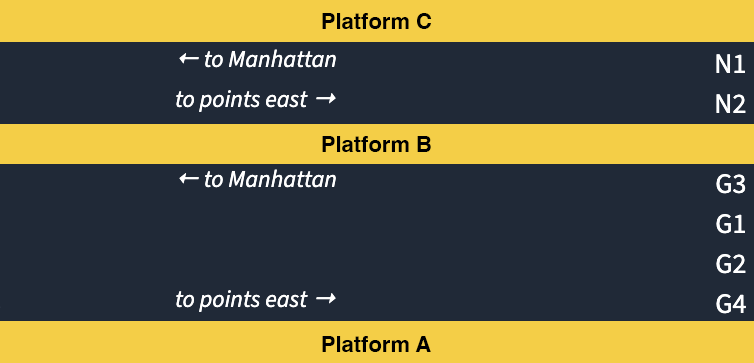
The Woodside Train Camera broadcasts live from Woodside station on the Long Island Rail Road main line, seeing over 1,300 LIRR and New York City Subway trains every day.
The Long Island Rail Road is the oldest commuter railroad in the United States still operated by its original operating company, founded in 1834. It is also the busiest, carrying over 250,000 passengers every weekday. The New York City Subway Flushing Line ( and
trains) is one of the busiest subway lines in the city (and country), carrying hundreds of thousands of riders per day between Manhattan and Flushing, Queens. These two rail lines make Woodside one of the busiest stations in the country (by number of passengers and trains who pass through it), and the Woodside Train Camera the busiest railfan camera on the continent.
FAQ
Where is the camera located?
The camera is located near Woodside Station in Queens, a borough of New York City, on private property.How can I support the stream?
We accept tips to help pay for hardware upgrades to make the stream better on our Ko-Fi.What kind of trains pass through?
A variety of trains pass through Woodside. On the Long Island Rail Road, three generations of electric multiple unit trains (Budd-built M3, Bombardier-built M7, and Kawasaki-built M9) and diesel-hauled Kawasaki-built C3 coaches carry LIRR passengers west on trains to Manhattan's Penn Station and Grand Central Terminals, as well as Long Island City and east to Port Washington, Jamaica and points east. Situated on the mainline west of Jamaica, Woodside sees some of Long Island's busiest trains, including the summer-Fridays-only Cannonball express train to the Hamptons and Montauk, trains to events at Citi Field (home of the Mets) and Forest Hills.
Included in the stream is a board that shows the next trains to arrive on each track and its destination. Most trains are numbered, and referred to by their number or the time they depart, but some trains are named, like The Cannonball. More trains have unofficial names, like The Musketball, the Thursday version of the Cannonball, or The Jamaicler (our name), the last train from Grand Central every night.
On the tracks above, New York City Subway and
trains run 24 hours a day, with
express trains running during rush hours in the peak direction of travel (west in the AM, east in the PM).
How are the tracks laid out?
The track layout at Woodside can be confusing, but once you learn the underlying logic, it makes sense. If you ever get confused, the board in the bottom left of the stream is configured to match the physical layout of tracks!

Starting from the top of the frame, we have the New York City Subway's Flushing Line ( and
trains). The far track is the southbound local track, or track 1—sometimes called C1. In the Subway, all trains are considered to run north or south. In Queens, southbound means "towards Manhattan" and northbound means "away from Manhattan." C1 carries trains toward Manhattan. Below that is track M (or CM), or the middle track, it carries express trains north or south, depending on the time of day. Below that is the northbound local track, aka track 2 or C2, carrying trains away from Manhattan, toward Flushing–Main St.
On the Long Island Rail Road, the furthest two tracks are on the Port Washington Branch, which branches off the mainline west of the camera, at Harold Junction. The far track, N1, carries trains toward Manhattan, and below that N2 carries trains east to Citi Field, Flushing, Port Washington, and points in between.
Below the Port Washington Branch is the mainline, the busiest section. On the Long Island Rail Road, tracks are numbered from the center out. This was done to allow for additional tracks to be added without requiring renumbering, and conveniently it means that odd numbered tracks generally carry trains toward New York and even numbered tracks carry them away. The top track, called G3, always carries trains toward Manhattan. Below that is G1, which generally carries trains toward Manhattan, but is sometimes reversed to provide extra capacity going east in the PM rush. Below G1 is G2, which generally carries traffic away from Manhattan, but is sometimes reversed to allow more trains to run west in the AM rush. Last but not least is G4, which always carries trains toward Jamaica and points east. Main line tracks west of Jamaica are officially prefixed with a G, but often they are referred to by ML, short for main line.
That was a lot of information, but there are a couple ways to remember it more easily. The order, from top to bottom, is 1-2-3-1-2-4, but only trains on N1/2 and G3/4 can stop, so platform tracks are numbered 1-2-3-4 from top to bottom. All the even numbered tracks generally carry trains away from Manhattan, and the odds toward Manhattan.
Lastly, the platforms are lettered, from bottom-to-top, A-B-C. A exclusively serves eastbound trains on track G4, B serves westbound trains on G3 and eastbound (to Port Washington) trains on N2, and Platform C exclusively serves westbound trains from Port Washington.Trains that will not make a station-stop at Woodside are shown in italics.
How can I contact you?
There is a contact email located in the about section of our YouTube page, though chances are, members of our Discord server can answer any questions you have!Are you affiliated with the MTA, New York City Transit or the Long Island Rail Road?
No. This camera is run by a member of the public, and has no affiliation whatsoever with the Metropolitan Transportation Authority or any of its subsidiaries.Copyright © 2025 Woodside Train Camera